Design of an Efficient MPPT Topology Based on a Grey Wolf Optimizer-Particle Swarm Optimization (GWO-PSO) Algorithm for a Grid-Tied Solar Inverter Under Variable Rapid-Change Irradiance
Abstract
1. Introduction
- A new MPPT approach is presented for grid-tied solar inverter systems, which utilizes GWO and PSO algorithms to increase tracking effectiveness.
- The proposed method is compared with some classical methods, and this proved to be more efficient, with faster response, reduced oscillations, and improved energy extraction.
- Grid-tied system stability and power quality are enhanced when the solar array is subjected to variable weather conditions.
2. Grid-Tied Solar Inverter
2.1. Grid-Tied Inverter Operation
2.2. Modelling of Grid-Tied Inverter
- , are the voltages of the αβ component.
- , , and are the grid voltages of phase a, b, and c.
- , are the currents of the αβ component.
- , , and are the grid currents of phase a, b, and c.
- are the grid voltages of the dq component.
- are the grid currents of the dq component.
3. Proposed PV System
3.1. Proposed MPPT Method
3.2. Proposed Hybrid MPPT Method
3.2.1. PSO Algorithm
3.2.2. GWO Algorithm
3.2.3. Proposed GWO-PSO Algorithm
4. Results and Discussion
4.1. Case 1: Step Change in Irradiance
4.2. Case 2: Variable Varying in Irradiance
4.3. Case 3: Comparison with Existing Methods
- PSO has slightly higher settling and rise times of 0.106 s and 0.24 s, respectively. In overshoot, however, it exceeds the mark, showing a value of 4.3%. It shows efficiency but a lack of stability compared to GWO-PSO.
- GWO achieves moderate performance. We recorded the rise time and settling time at 0.36 s and 0.145 s, respectively. A 7% overshoot suggests a higher fluctuation range of a given output signal before a steady state is achieved.
- HHO has the slowest response with the greatest rise time (0.40 s) and has the longest settling time (0.178 s). Further, its overshoot of 9% indicates significant fluctuations, which makes this method the least stable technique.
5. Conclusions
Author Contributions
Funding
Data Availability Statement
Acknowledgments
Conflicts of Interest
Abbreviations
| DOAJ | Directory of open access journals |
| LD | Linear dichroism |
References
- Shafiullah, M.; Ahmed, S.D.; Al-Sulaiman, F.A. Grid Integration Challenges and Solution Strategies for Solar PV Systems: A Review. IEEE Access 2022, 10, 52233–52257. [Google Scholar] [CrossRef]
- Bialasiewicz, J.T. Renewable Energy Systems with Photovoltaic Power Generators: Operation and Modeling. IEEE Trans. Ind. Electron. 2008, 55, 2752–2758. [Google Scholar] [CrossRef]
- Abbas, F.A.; A.Obed, A.; Alhasiri, A.; Yaqoob, S.J. A Hybrid Renewable Sources Implementation for a DC Microgrid with Flatness-Nonlinear Control to Achieve Efficient Energy Management Strategy. J. Tech. 2023, 5, 16–27. [Google Scholar] [CrossRef]
- Khalaf, H.H.; Al-Sagar, Z.S.; Mohammad, A.T.; Fadhil, H.A. Optimization of Neurons Number in Artificial Neural Network Model for Predicting the Power Production of PV Module. J. Tech. 2024, 6, 69–77. [Google Scholar] [CrossRef]
- Kadhim, N.A.; Obed, A.A.; Abid, A.J.; Saleh, A.L.; Hassoon, R.J. A Systematic Review for Reconfiguring Photovoltaic Arrays under Conditions of Partial Shading. Electr. Eng. Tech. J. 2024, 1, 20–34. [Google Scholar] [CrossRef]
- Shaker, F.N.; Obed, A.A.; Abid, A.J.; Saleh, A.L.; Hassoon, R.J. Energy Management Strategy for PV PSO MPPT / Fuel Cell/Battery Hybrid System with Hydrogen Production and Storage. J. Tech. 2023, 5, 52–60. [Google Scholar] [CrossRef]
- Yaqoob, S.; Hussein, A.; Saleh, A.L. Low Cost and Simple P&O-MPP Tracker Using Flyback Converter. Solid State Technol. 2020, 63, 9676–9689. [Google Scholar]
- Yaqoob, S.J.; Obed, A.A. Modeling, Simulation and Implementation of PV System by Proteus Based on Two-Diode Model. J. Tech. 2019, 1, 39–51. [Google Scholar] [CrossRef]
- Shi, J.; Zhang, W.; Zhang, Y.; Xue, F.; Yang, T. MPPT for PV Systems Based on a Dormant PSO Algorithm. Electr. Power Syst. Res. 2015, 123, 100–107. [Google Scholar] [CrossRef]
- González-Castaño, C.; Restrepo, C.; Kouro, S.; Rodriguez, J. MPPT Algorithm Based on Artificial Bee Colony for PV System. IEEE Access 2021, 9, 43121–43133. [Google Scholar] [CrossRef]
- Tian, A.-Q.; Chu, S.-C.; Pan, J.-S.; Liang, Y. A Novel Pigeon-Inspired Optimization Based MPPT Technique for PV Systems. Processes 2020, 8, 356. [Google Scholar] [CrossRef]
- Eltamaly, A.M. A Novel Musical Chairs Algorithm Applied for MPPT of PV Systems. Renew. Sustain. Energy Rev. 2021, 146, 111135. [Google Scholar] [CrossRef]
- Pradhan, C.; Senapati, M.K.; Ntiakoh, N.K.; Calay, R.K. Roach Infestation Optimization MPPT Algorithm for Solar Photovoltaic System. Electronics 2022, 11, 927. [Google Scholar] [CrossRef]
- Kumar, D.; Chauhan, Y.K.; Pandey, A.S.; Srivastava, A.K.; Kumar, V.; Alsaif, F.; Elavarasan, R.M.; Islam, M.R.; Kannadasan, R.; Alsharif, M.H. A Novel Hybrid MPPT Approach for Solar PV Systems Using Particle-Swarm-Optimization-Trained Machine Learning and Flying Squirrel Search Optimization. Sustainability 2023, 15, 5575. [Google Scholar] [CrossRef]
- Chao, K.-H.; Rizal, M.N. A Hybrid MPPT Controller Based on the Genetic Algorithm and Ant Colony Optimization for Photovoltaic Systems under Partially Shaded Conditions. Energies 2021, 14, 2902. [Google Scholar] [CrossRef]
- Ahmed, H.S.; Abid, A.J.; Obed, A.A.; Saleh, A.L.; Hassoon, R.J. Maximizing Energy Output of Photovoltaic Systems: Hybrid PSO-GWO-CS Optimization Approach. J. Tech. 2023, 5, 174–184. [Google Scholar] [CrossRef]
- Refaat, A.; Ali, Q.A.; Elsakka, M.M.; Elhenawy, Y.; Majozi, T.; Korovkin, N.V.; Elfar, M.H. Extraction of Maximum Power from PV System Based on Horse Herd Optimization MPPT Technique under Various Weather Conditions. Renew. Energy 2024, 220, 119718. [Google Scholar] [CrossRef]
- Xu, S.-Z.; Zhong, Y.-M. NSNPSO-INC: A Simplified Particle Swarm Optimization Algorithm for Photovoltaic MPPT Combining Natural Selection and Conductivity Incremental Approach. IEEE Access 2024, 12, 137760–137774. [Google Scholar] [CrossRef]
- Lei, G.; Yan, C.; Cai, L.; He, C.; Dai, N.; Li, S.; Liu, J. IGWO-VINC Algorithm Applied to MPPT Strategy for PV System. Int. J. Photoenergy 2024, 2024, 1664320. [Google Scholar] [CrossRef]
- Bouchakour, A.; Borni, A.; Brahami, M. Comparative Study of P&O-PI and Fuzzy-PI MPPT Controllers and Their Optimisation Using GA and PSO for Photovoltaic Water Pumping Systems. Int. J. Ambient Energy 2021, 42, 1746–1757. [Google Scholar] [CrossRef]
- Elymany, M.M.; Enany, M.A.; Elsonbaty, N.A. Hybrid Optimized-ANFIS Based MPPT for Hybrid Microgrid Using Zebra Optimization Algorithm and Artificial Gorilla Troops Optimizer. Energy Convers. Manag. 2024, 299, 117809. [Google Scholar] [CrossRef]
- Chtita, S.; Motahhir, S.; El Hammoumi, A.; Chouder, A.; Benyoucef, A.S.; El Ghzizal, A.; Derouich, A.; Abouhawwash, M.; Askar, S.S. A Novel Hybrid GWO–PSO-Based Maximum Power Point Tracking for Photovoltaic Systems Operating Under Partial Shading Conditions. Sci. Rep. 2022, 12, 10637. [Google Scholar] [CrossRef]
- Baso, N.F.; Suryoatmojo, H.; Fahmi, D.; Windarko, N.A. An Improvement GWO-P&O Algorithm Based MPPT for PV System under Partial Shading Condition. In Proceedings of the 2024 International Electronics Symposium (IES), Denpasar, Indonesia, 6 August 2024; IEEE: Surabaya, Indonesia, 2024; pp. 54–59. [Google Scholar]
- Abdullah, B.U.D.; Dhar, S.L.; Jaiswal, S.P.; Gulzar, M.M.; Alqahtani, M.; Khalid, M. Hybrid MPPT Control Using Hybrid Pelican Optimization Algorithm with Perturb and Observe for PV Connected Grid. Front. Energy Res. 2025, 12, 1505419. [Google Scholar] [CrossRef]
- Dandoussou, A.; Kenfack, P. Modelling and Analysis of Three-Phase Grid-Tied Photovoltaic Systems. J. Electr. Syst. Inf. Technol. 2023, 10, 26. [Google Scholar] [CrossRef]
- Chatterjee, S.; Kumar, P.; Chatterjee, S. A Techno-Commercial Review on Grid Connected Photovoltaic System. Renew. Sustain. Energy Rev. 2018, 81, 2371–2397. [Google Scholar] [CrossRef]
- Gad, A.G. Particle Swarm Optimization Algorithm and Its Applications: A Systematic Review. Arch. Comput. Methods Eng. 2022, 29, 2531–2561. [Google Scholar] [CrossRef]
- Mirjalili, S.; Mirjalili, S.M.; Lewis, A. Grey Wolf Optimizer. Adv. Eng. Softw. 2014, 69, 46–61. [Google Scholar] [CrossRef]
- Ikram, M.; Liu, H.; Al-Janabi, A.M.; Kisi, O.; Mo, W.; Ali, M.; Adnan, R.M. Enhancing the Prediction of Influent Total Nitrogen in Wastewater Treatment Plant Using Adaptive Neuro-Fuzzy Inference System–Gradient-Based Optimization Algorithm. Water 2024, 16, 3038. [Google Scholar] [CrossRef]
- Singh, N.; Singh, S.B. Hybrid Algorithm of Particle Swarm Optimization and Grey Wolf Optimizer for Improving Convergence Performance. J. Appl. Math. 2017, 2017, 2030489. [Google Scholar] [CrossRef]
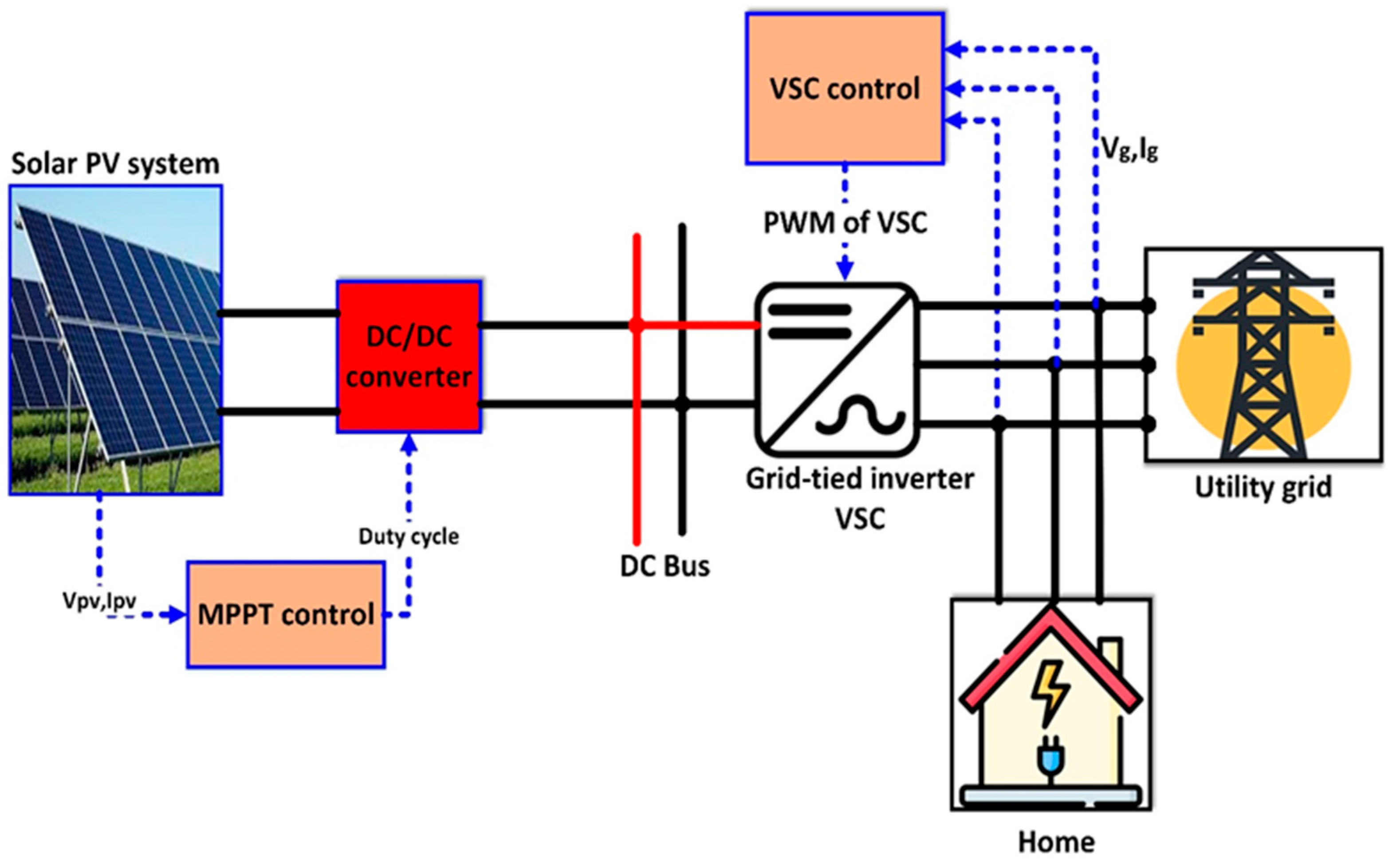
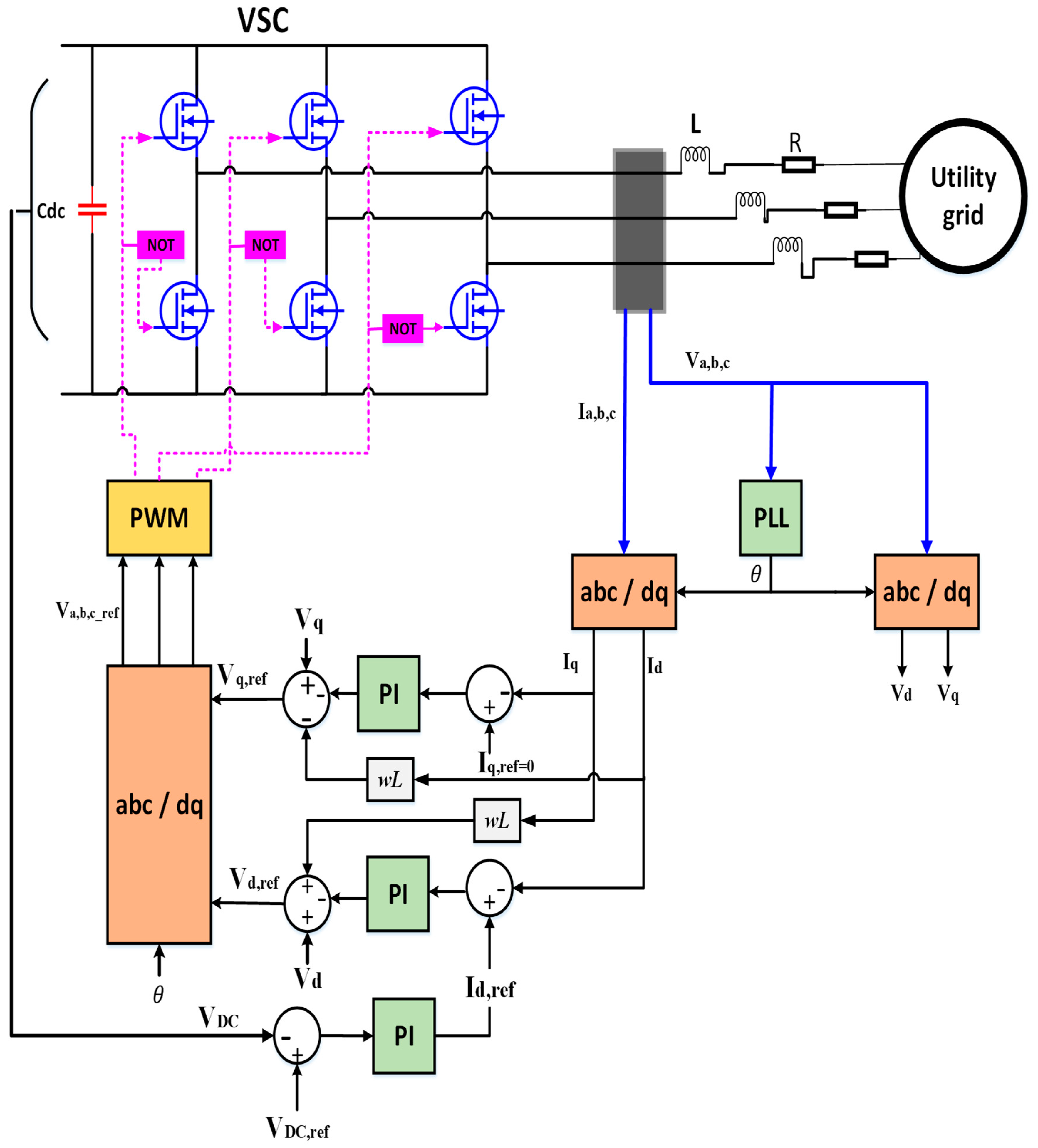

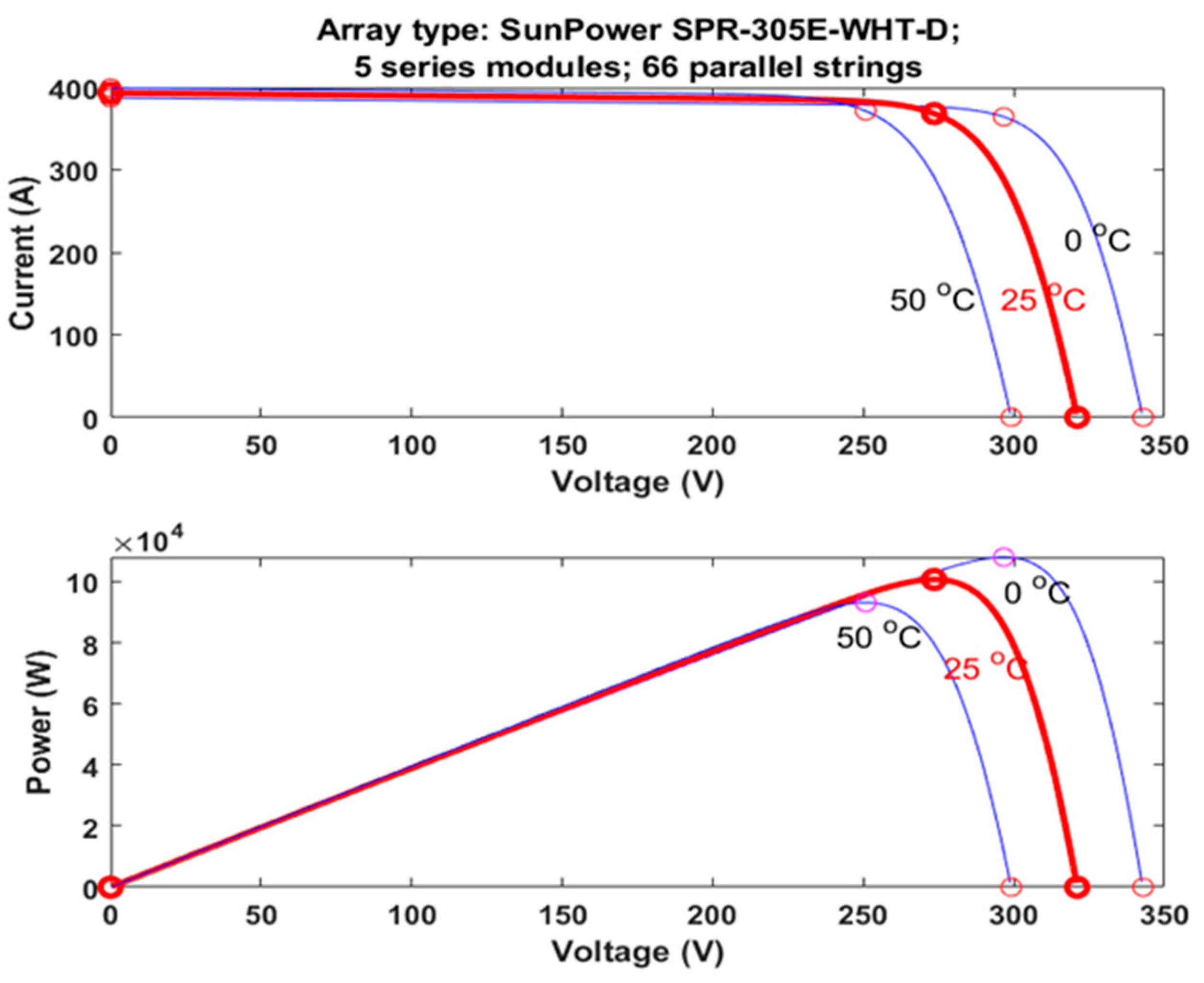
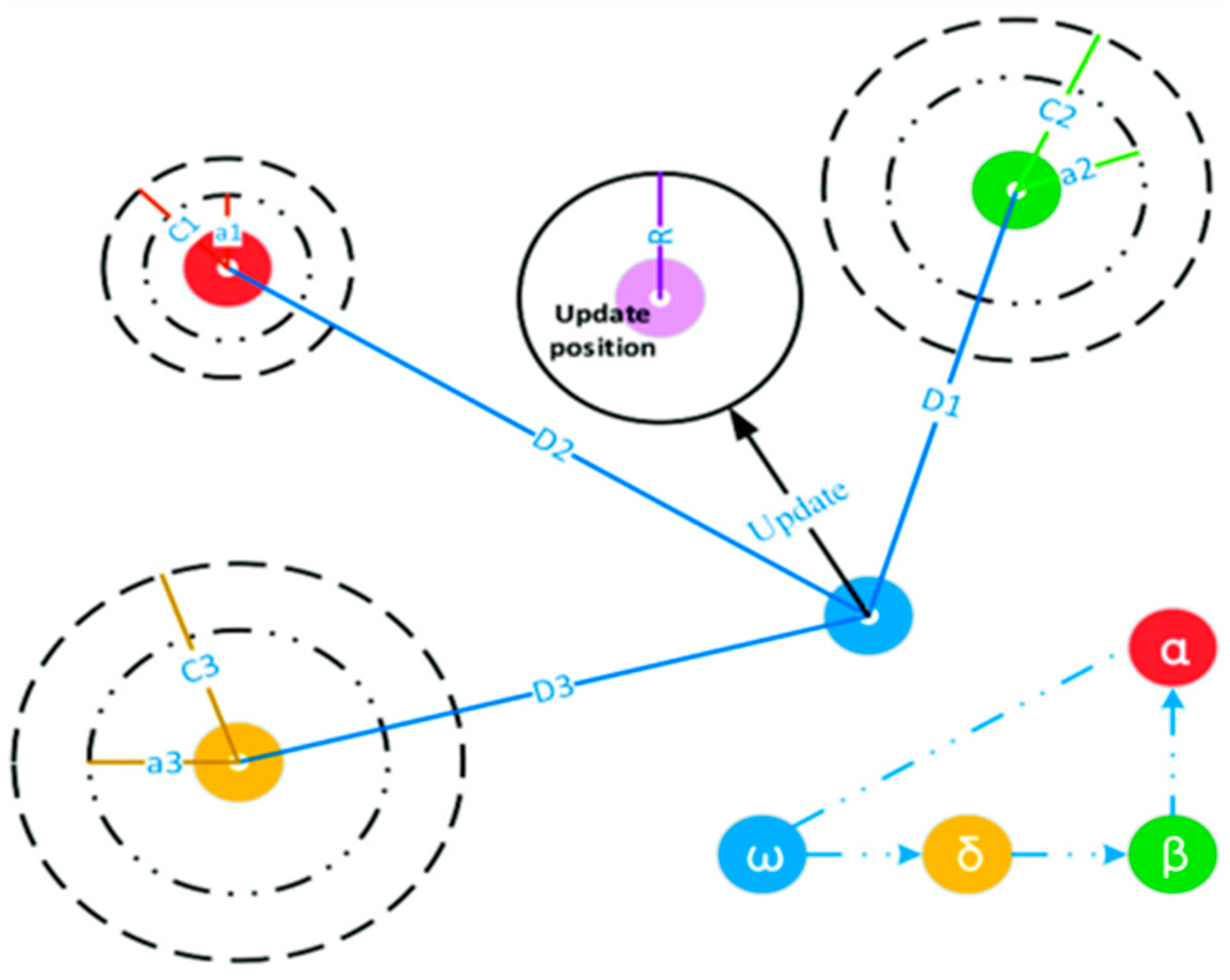
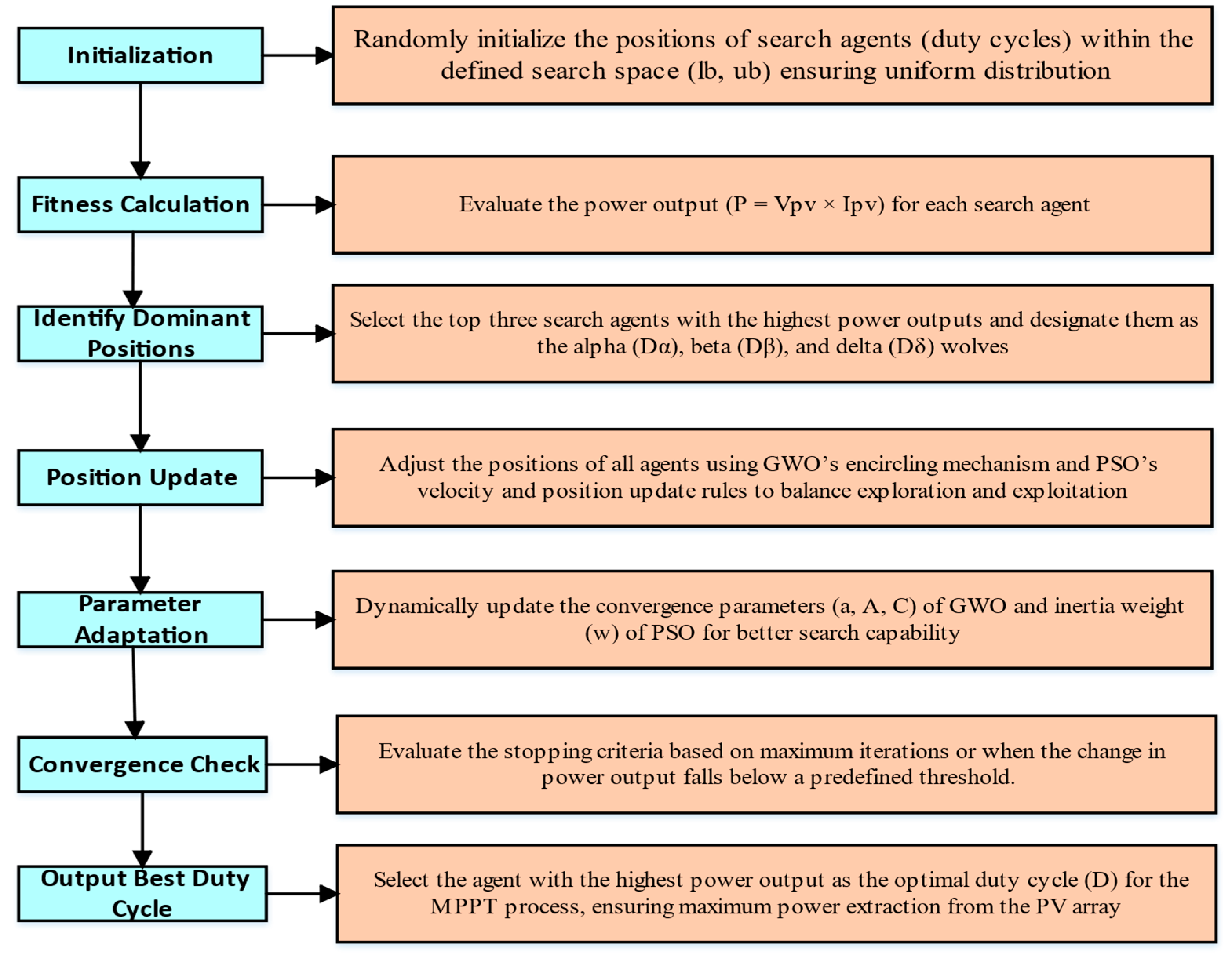


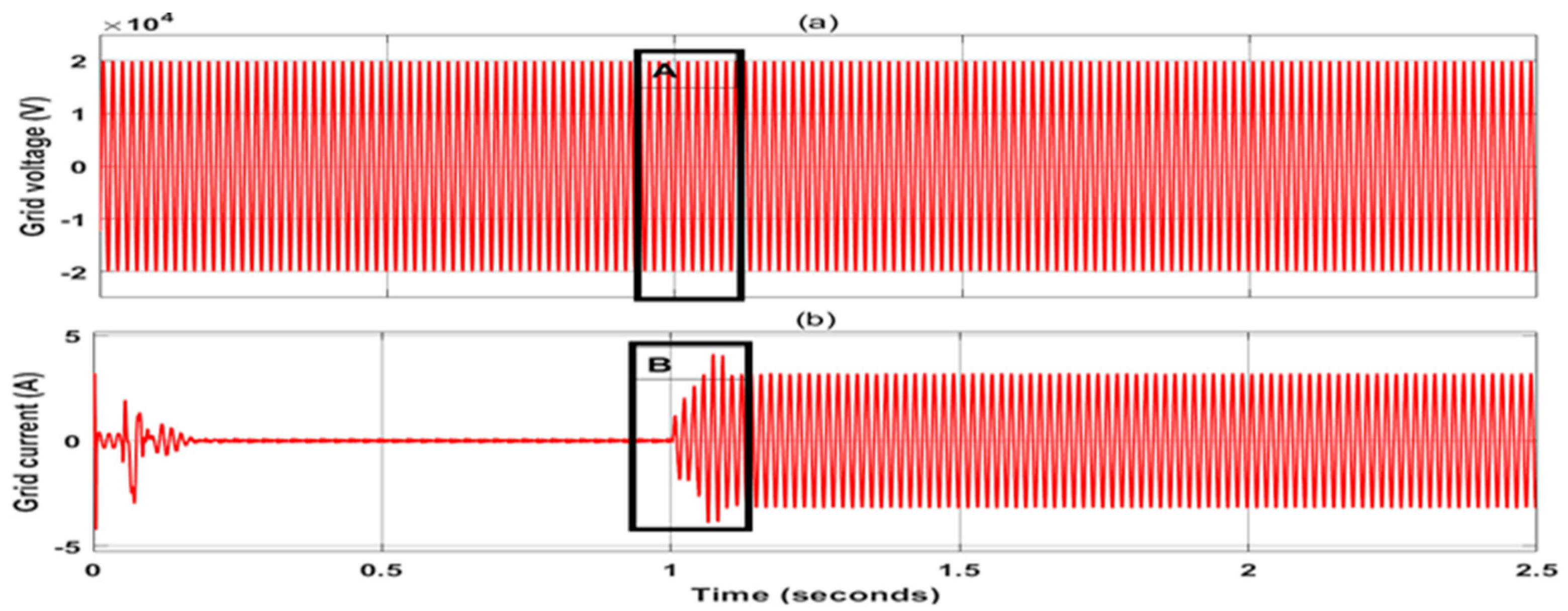

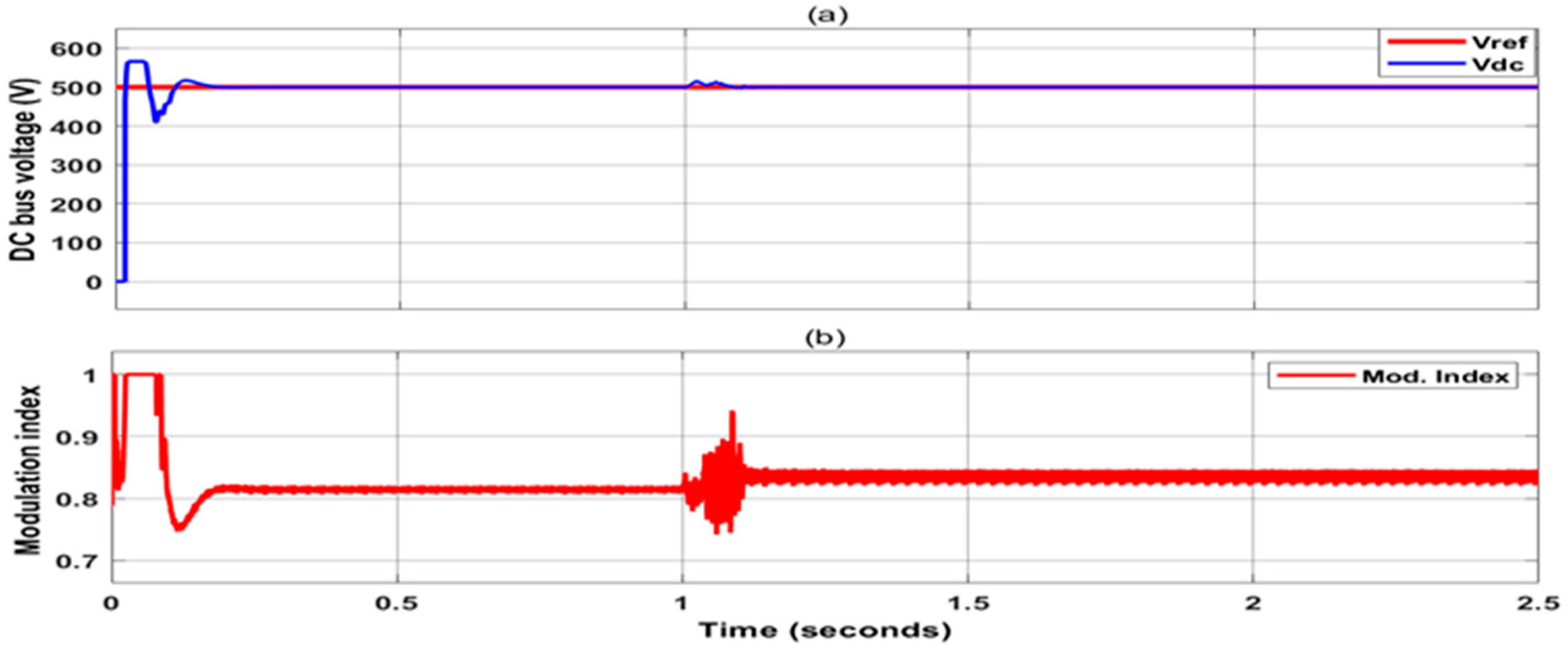


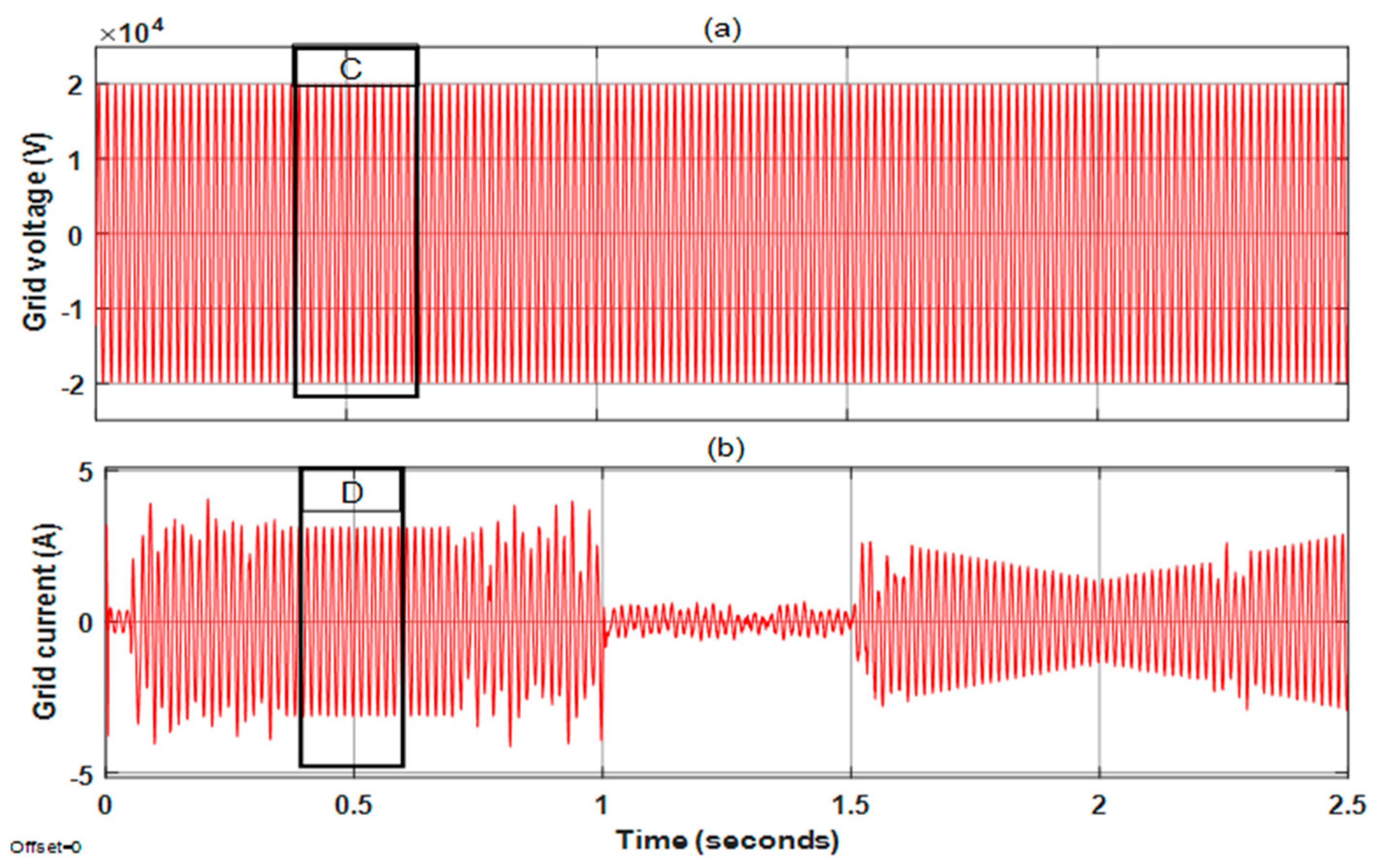

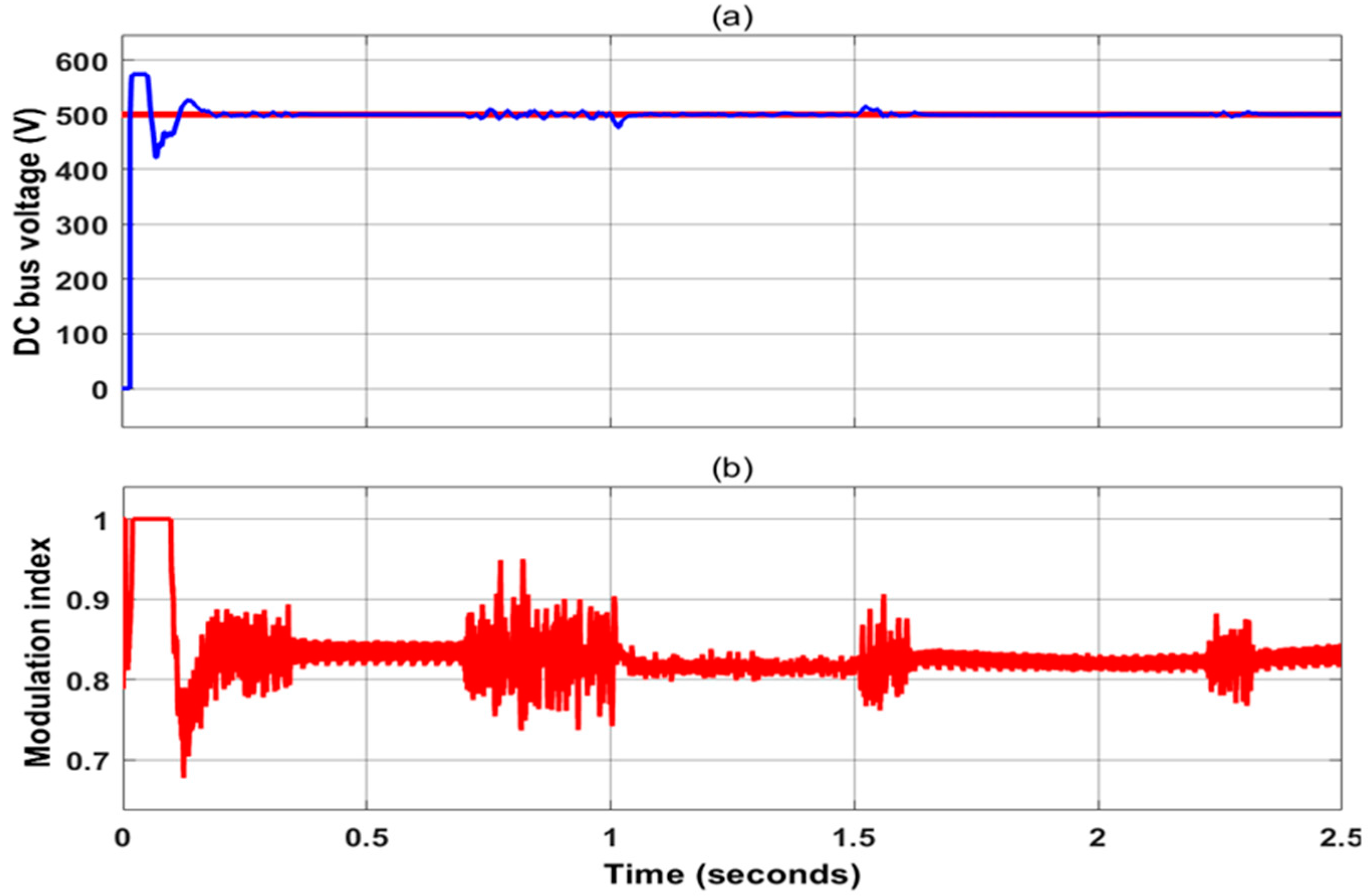
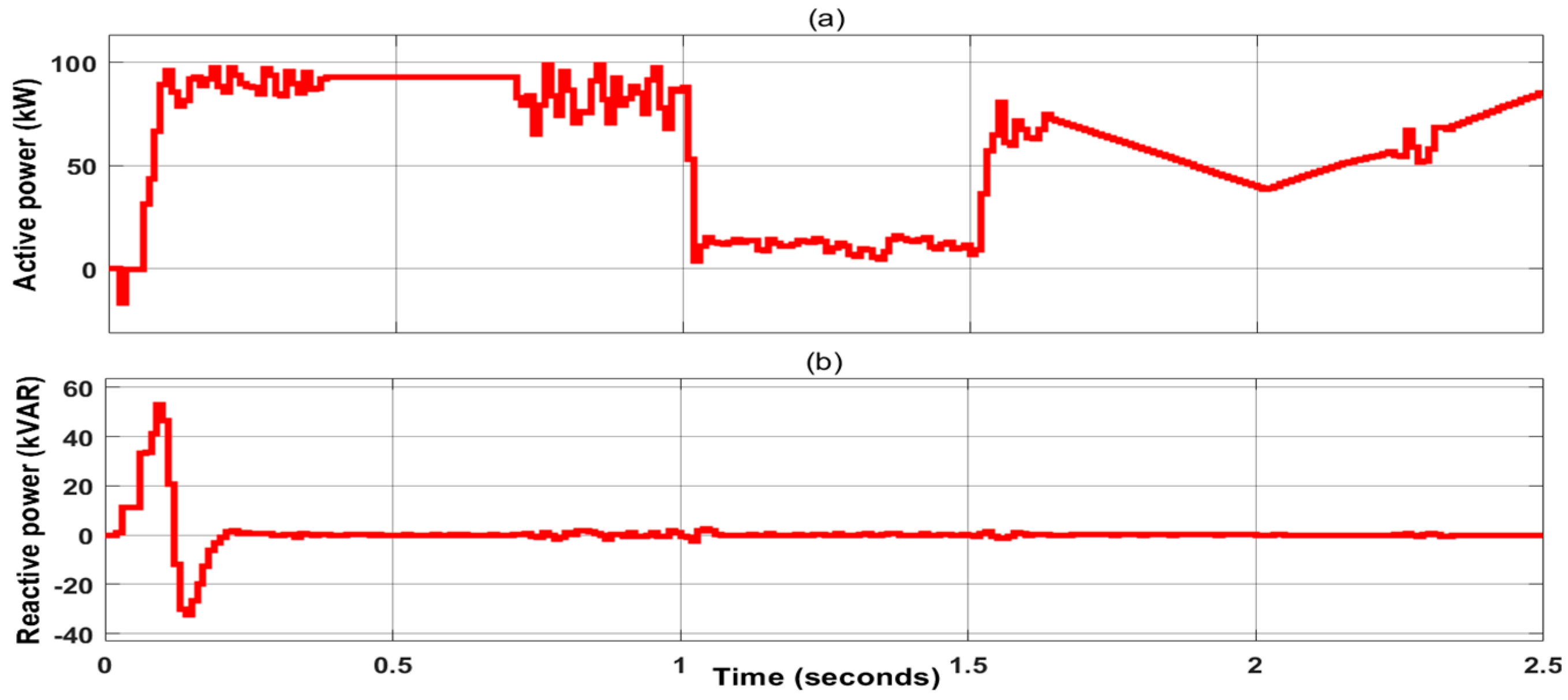
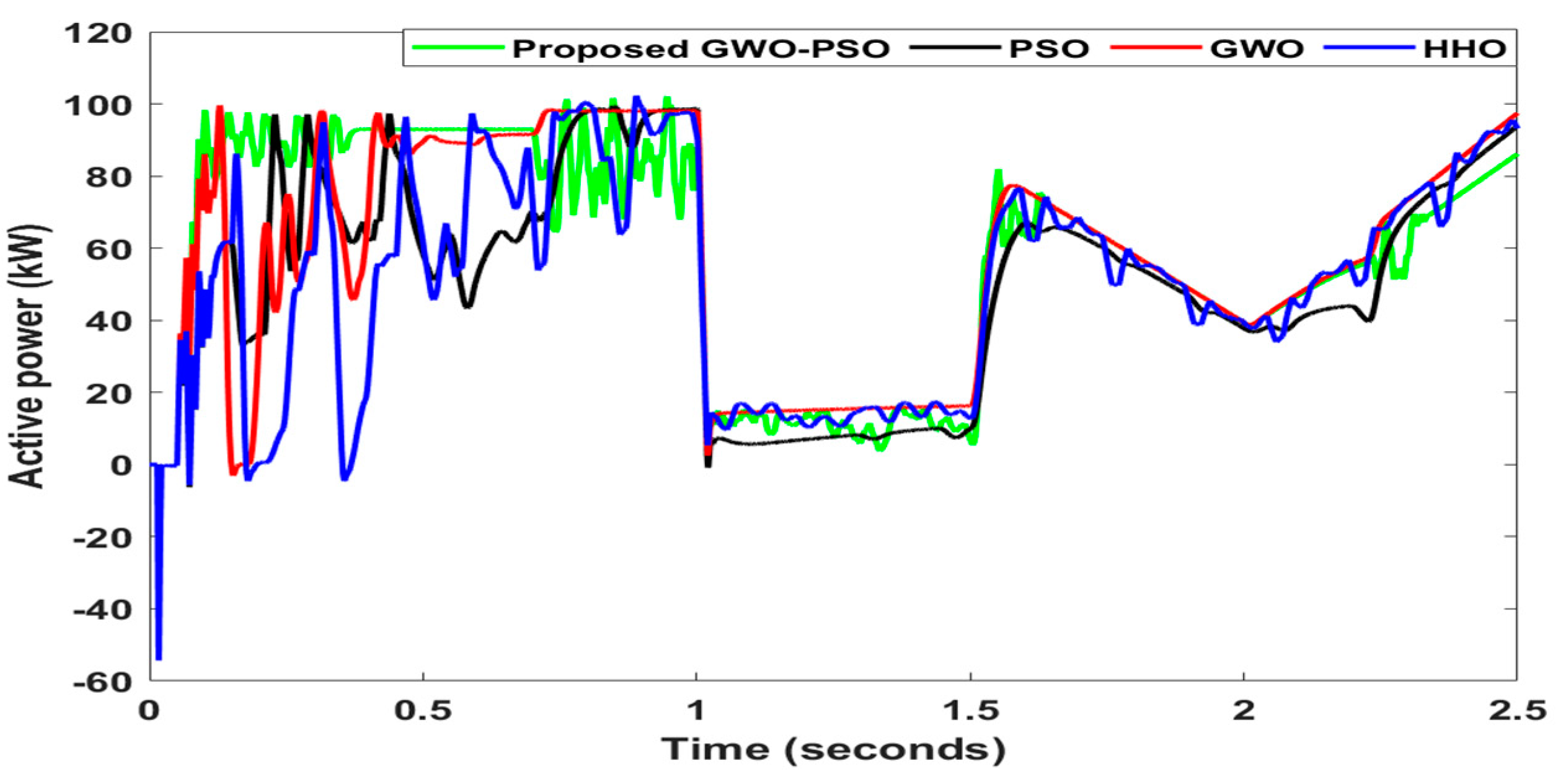

| Description | Value |
|---|---|
| Inertia Weight, | |
| Learning Coefficient | |
| Upper limit and lower limit | 0.3–0.9 |
| MPPT Algorithm | Active Power of Grid | DC Bus Voltage | ||||
|---|---|---|---|---|---|---|
| Overshoot (%) | Rise Time (s) | Settling Time (s) | Overshoot (%) | Rise Time (s) | Settling Time (s) | |
| Proposed | 4 | 0.118 | 0.260 | 2.7 | 0.17 | 0.71 |
| PSO | 7 | 0.203 | 0.360 | 4.3 | 0.24 | 0.106 |
| GWO | 9 | 0.245 | 0.650 | 7 | 0.36 | 0.145 |
| HHO | 11 | 0.280 | 0.800 | 9 | 0.4 | 0.178 |
Disclaimer/Publisher’s Note: The statements, opinions and data contained in all publications are solely those of the individual author(s) and contributor(s) and not of MDPI and/or the editor(s). MDPI and/or the editor(s) disclaim responsibility for any injury to people or property resulting from any ideas, methods, instructions or products referred to in the content. |
© 2025 by the authors. Licensee MDPI, Basel, Switzerland. This article is an open access article distributed under the terms and conditions of the Creative Commons Attribution (CC BY) license (https://creativecommons.org/licenses/by/4.0/).
Share and Cite
Taha, S.A.; Al-Sagar, Z.S.; Abdulsada, M.A.; Alruwaili, M.; Ibrahim, M.A. Design of an Efficient MPPT Topology Based on a Grey Wolf Optimizer-Particle Swarm Optimization (GWO-PSO) Algorithm for a Grid-Tied Solar Inverter Under Variable Rapid-Change Irradiance. Energies 2025, 18, 1997. https://doi.org/10.3390/en18081997
Taha SA, Al-Sagar ZS, Abdulsada MA, Alruwaili M, Ibrahim MA. Design of an Efficient MPPT Topology Based on a Grey Wolf Optimizer-Particle Swarm Optimization (GWO-PSO) Algorithm for a Grid-Tied Solar Inverter Under Variable Rapid-Change Irradiance. Energies. 2025; 18(8):1997. https://doi.org/10.3390/en18081997
Chicago/Turabian StyleTaha, Salah Abbas, Zuhair S. Al-Sagar, Mohammed Abdulla Abdulsada, Mohammed Alruwaili, and Moustafa Ahmed Ibrahim. 2025. "Design of an Efficient MPPT Topology Based on a Grey Wolf Optimizer-Particle Swarm Optimization (GWO-PSO) Algorithm for a Grid-Tied Solar Inverter Under Variable Rapid-Change Irradiance" Energies 18, no. 8: 1997. https://doi.org/10.3390/en18081997
APA StyleTaha, S. A., Al-Sagar, Z. S., Abdulsada, M. A., Alruwaili, M., & Ibrahim, M. A. (2025). Design of an Efficient MPPT Topology Based on a Grey Wolf Optimizer-Particle Swarm Optimization (GWO-PSO) Algorithm for a Grid-Tied Solar Inverter Under Variable Rapid-Change Irradiance. Energies, 18(8), 1997. https://doi.org/10.3390/en18081997






